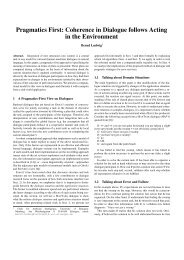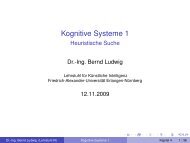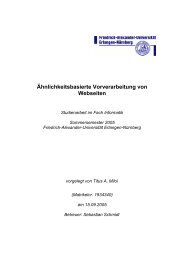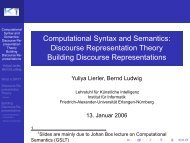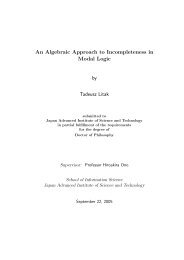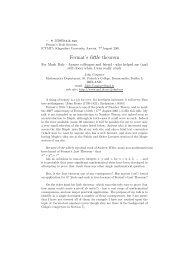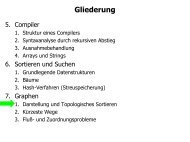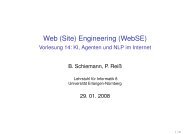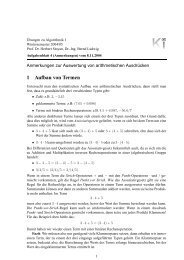Cognitive Systems II Contact: david@elsweiler.co.uk
Cognitive Systems II Contact: david@elsweiler.co.uk
Cognitive Systems II Contact: david@elsweiler.co.uk
- No tags were found...
Create successful ePaper yourself
Turn your PDF publications into a flip-book with our unique Google optimized e-Paper software.
Last Week's 1 minute paper●We have 2 boxes (red and blue) each <strong>co</strong>ntaining anumber of oranges and apples.●Without looking they pick a box at random and get anapple.●What is the probability that it was picked out of the redbox?
BurglaryP(B)0.001EarthquakeP(E)0.002B EP(A| B,E)AlarmT T 0.95T F 0.94F T 0.29F F 0.001John CallsAP(J|A)T 0.9F 0.05Mary CallsAP(M|A)T 0.7F 0.01
Inferences with Belief NetworksDiagnostic Inferences (from effects to causes)– What is the probability of a burglary given weknow that John calls → P (B | JC) = 0.016Causal Inferences (from causes to effects)– Given a burglary what is :P (JC | B) = 0.86 andP (MC |B) = 0.67
Inferences SummaryQEQEEQEQEDiagnosticCausalInter-CausalMixed
Algorithm for Belief Networks thatare Poly-treesAlgorithm for making inferences where the beliefnetwork is a poly-tree– There is at most one undirected path betweennodesWill work with all four kinds of inferences outlinedabove
U 1U mx
U 1U mxY 1Y n
U 1U mxZ 1jZ njY 1Y n
+EU x1U mxZ 1j Z njY 1Y n
Answering Queries+EU x1U mxZ 1j Z njY 1Y nE x-
Answering Queries●X is the query variable● U = U 1… U mare parents of node X● Y = Y 1… Y nare children of node X●E is a set of evidence variables●The aim is to <strong>co</strong>mpute P (X | E)
Answering Queries● E X + is the causal support for X●The evidence variables “above” X that are<strong>co</strong>nnected to X through its parents● E X - is the evidential support for X●The evidence variables “below” X that are<strong>co</strong>nnected to X through its children● E ui \ Xrefers to all the evidence <strong>co</strong>nnected to nodeU iexcept via the path from X● E yi \ X+refers to all the evidence <strong>co</strong>nnected tonode Yi through its parents except X
E ui \ XXXXXU 1U mXXXXx
E yi \ X+XXxXXXZ 1jXY 1XY nXZ njX
Computing P(X|E)Since X d-separates from we canuse <strong>co</strong>nditional independence to simplify thefirst term in the numerator
Answering Queries+EU x1U mxZ 1j Z njY 1Y nE x-
Computing P(X|E)Since X d-separates from we canuse <strong>co</strong>nditional independence to simplify thefirst term in the numeratorWe can treat the denominator as a <strong>co</strong>nstant
ComputingWe want to <strong>co</strong>nsider all the possible <strong>co</strong>mbinationsof parents of X and examine how likely they aregivenLet be the vector of parents andlet u be the assignment of values to them
Computingd-separates X fromsimplifies toso the first term
XXXU 1 U mE x+XXXXXx
ComputingWe can simplify the se<strong>co</strong>nd term by noting●Given X D-separates from the otherparents●Joint probability of independent variables issimply their product
U 1 U mE x+x
Computingd-separates X fromsimplifies toso the first termWe can simplify the se<strong>co</strong>nd term by noting●Given X D-separates from the otherparents●Joint probability of independent variables issimply their product
ComputingThe last term can be simplified by splittingintoand noting thatis D-separated by X from the rest of
XXXU 1 U mE x+XXXXXx
Computing●is a simple lookup in the <strong>co</strong>nditionalprobability table for X●is a recursive (smaller) subproblem
Computing P(X|E)Since X d-separates from we canuse <strong>co</strong>nditional independence to simplify thefirst term in the numeratorWe can treat the denominator as a <strong>co</strong>nstant
ComputingLet Z ibe the parents of Y iother than X, and z ibethe assignment of values to the parentsThe evidence of each Y iis <strong>co</strong>nditionallyindependent of the others given X
XXxXXXZ 1jXY 1XY nXZ njXX X X X
ComputingAveraging over and gives
ComputingBreaking<strong>co</strong>mponents ofinto the two independentand
XXxXZ 1jXZ 1jXY 1X
ComputingBreaking<strong>co</strong>mponents ofinto the two independentand
Computingis independent of X and given andis independent of X and
XXxZ 1jY 1Z 1jXXXY 1X
Computingis independent of X and given andis independent of X and
ComputingApply Bayes' rule to :
ComputingRewriting the <strong>co</strong>njunction of and gives:
Computing= because Z and X are d-separated. Alsois a <strong>co</strong>nstant
xZ 1jY 1Y 1
Computing= because Z and X are d-separated. Alsois a <strong>co</strong>nstant
ComputingThe Zijs are all independent of each otherWe can <strong>co</strong>mbine thes into a single
xZ 11Y 1Z 1jZ 12Z 1jY 1
Computing●is a recursive instance of●is a <strong>co</strong>nd prob table entry for Y i●is a recursive instance of
Multiply-<strong>co</strong>nnected Belief NetworksCloudyP(C) = 0.5CP(S)CP(R)T 0.1F 0.5SprinklerRainT 0.8F 0.2Wet GrassS R P(W)T T 0.99T F 0.9F T 0.9F F 0.00
Inference with Multiply-<strong>co</strong>nnectedBelief NetworksClustering methods– Transform the net into a probabilisticallyequivalent (but topologically different) Poly-Treeby merging problem nodesConditioning methods– Instantiate variables to definite values and thenevaluate a poly-tree for each possibleinstantiation
Inference with Multiply-<strong>co</strong>nnectedBelief NetworksStochastic Simulation Methods– Use the network to generate a large number of<strong>co</strong>ncrete models of the domain that are<strong>co</strong>nsistent with the network distribution– Gives an approximation of the exact evaluation



